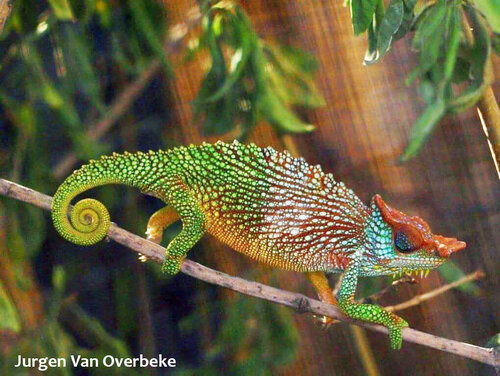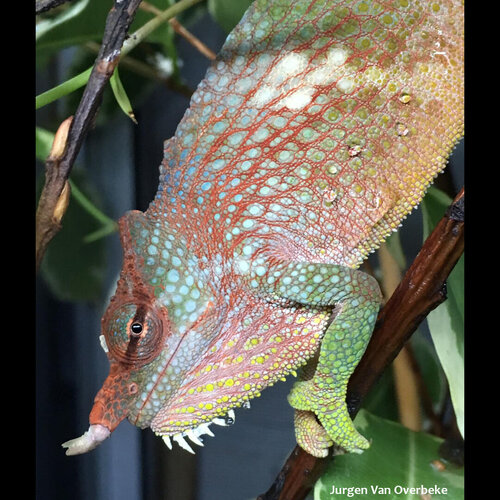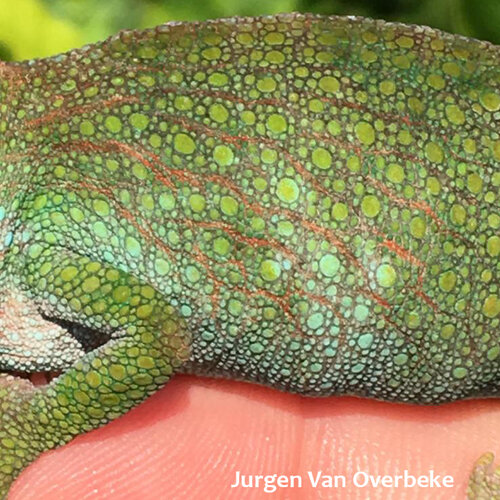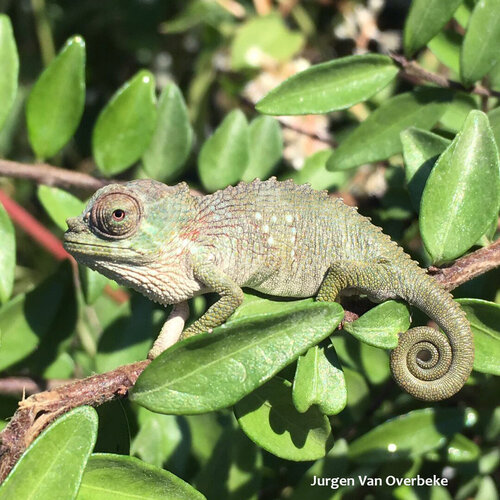Welcome to another installment of our World Chameleon Species Tour! Today we are in the Cameroon highlands with Trioceros pfefferi.
Natural History:
Trioceros pfefferi is a small size chameleon around the size of a carpet chameleon. It is listed as living between 1100m to 1900m by the IUCN, but there is an anecdotal report of them occurring higher by a trapper. Regardless of the upper range, T. pfefferi will need the typical montane conditions of a cool day and a nighttime drop. T. pfefferi is rarely exported and there is no indication that new exports will be coming in the foreseeable future. If we do get another chance with them, hopefully our present experience with T. quadricornis and T. serratus will ensure that those breeders are prepared.


The Male Trioceros pfefferi can show a striking array of patterns and colors - especially in the presence of a female or a rival.

Female Trioceros pfefferi
Husbandry & Breeding:
Jurgen Van Overbeke has successful bred this species and shares his experiences.
“Trioceros pfefferi is a small species where the males have two rostral horns on a green body with striking bright blues, white dots, and red veining. The females are a beautiful green with the same, but just more subtle, coloration
Since Trioceros pfefferi lives in such high elevations they are exceedingly sensitive to warm temperatures. They need cool temperatures in the lower 70s F during the day and a sharp drop at night. 75F is the maximum I advise to exposure them to. During the summer I have them outdoors for natural sunshine. They would bask in the early morning, but at the slightest hint of warmth they would retreat back into the leaves.
They had to be kept separate even as hatchlings. Plan for separate cages straight from the egg. The cages should be densely planted and hydration is the same as the other Cameroon species. Night time fogging keeps their hydration up and a misting in the morning and late afternoon. Ensures they are taken care of.
Breeding is not difficult. The females will lay 4-7 eggs up to three times a year. Incubation is around seven months at temperatures in the upper 60s. (18 – 20C)
One thing to note about T. pfefferi is that they are extra sensitive to synthetic vitamins. Just two doses can generate edema. So gutloading feeder insects is even more critical with this species. I give them a little bit of calcium powder, but I watch carefully with even this.
T. pfefferi is a definite candidate for breeding programs should the species become available again.”



Natural History:
Trioceros pfefferi is a small size chameleon around the size of a carpet chameleon. It is listed as living between 1100m to 1900m by the IUCN, but there is an anecdotal report of them occurring higher by a trapper. Regardless of the upper range, T. pfefferi will need the typical montane conditions of a cool day and a nighttime drop. T. pfefferi is rarely exported and there is no indication that new exports will be coming in the foreseeable future. If we do get another chance with them, hopefully our present experience with T. quadricornis and T. serratus will ensure that those breeders are prepared.

The Male Trioceros pfefferi can show a striking array of patterns and colors - especially in the presence of a female or a rival.

Female Trioceros pfefferi
Husbandry & Breeding:
Jurgen Van Overbeke has successful bred this species and shares his experiences.
“Trioceros pfefferi is a small species where the males have two rostral horns on a green body with striking bright blues, white dots, and red veining. The females are a beautiful green with the same, but just more subtle, coloration
Since Trioceros pfefferi lives in such high elevations they are exceedingly sensitive to warm temperatures. They need cool temperatures in the lower 70s F during the day and a sharp drop at night. 75F is the maximum I advise to exposure them to. During the summer I have them outdoors for natural sunshine. They would bask in the early morning, but at the slightest hint of warmth they would retreat back into the leaves.
They had to be kept separate even as hatchlings. Plan for separate cages straight from the egg. The cages should be densely planted and hydration is the same as the other Cameroon species. Night time fogging keeps their hydration up and a misting in the morning and late afternoon. Ensures they are taken care of.
Breeding is not difficult. The females will lay 4-7 eggs up to three times a year. Incubation is around seven months at temperatures in the upper 60s. (18 – 20C)
One thing to note about T. pfefferi is that they are extra sensitive to synthetic vitamins. Just two doses can generate edema. So gutloading feeder insects is even more critical with this species. I give them a little bit of calcium powder, but I watch carefully with even this.
T. pfefferi is a definite candidate for breeding programs should the species become available again.”



